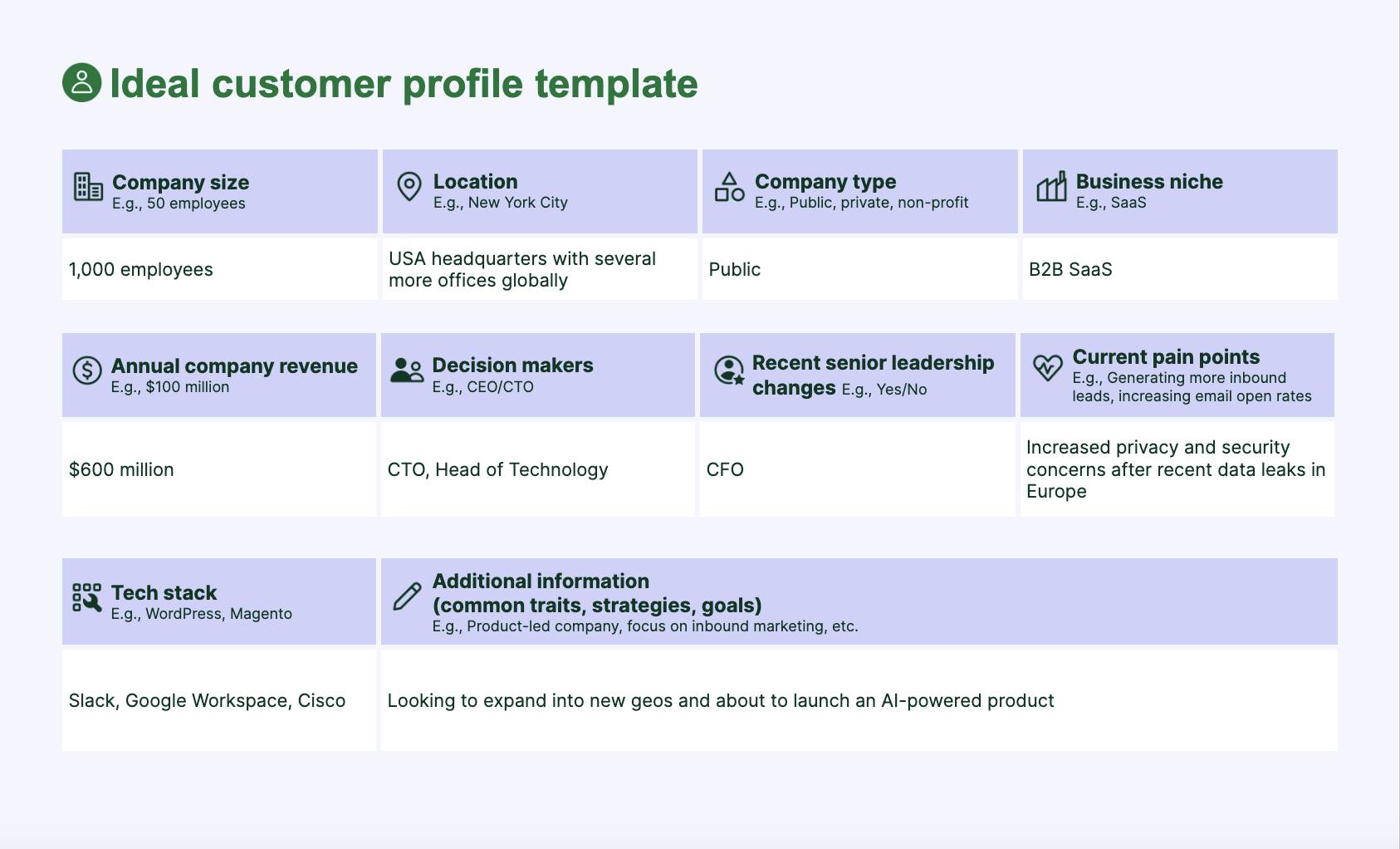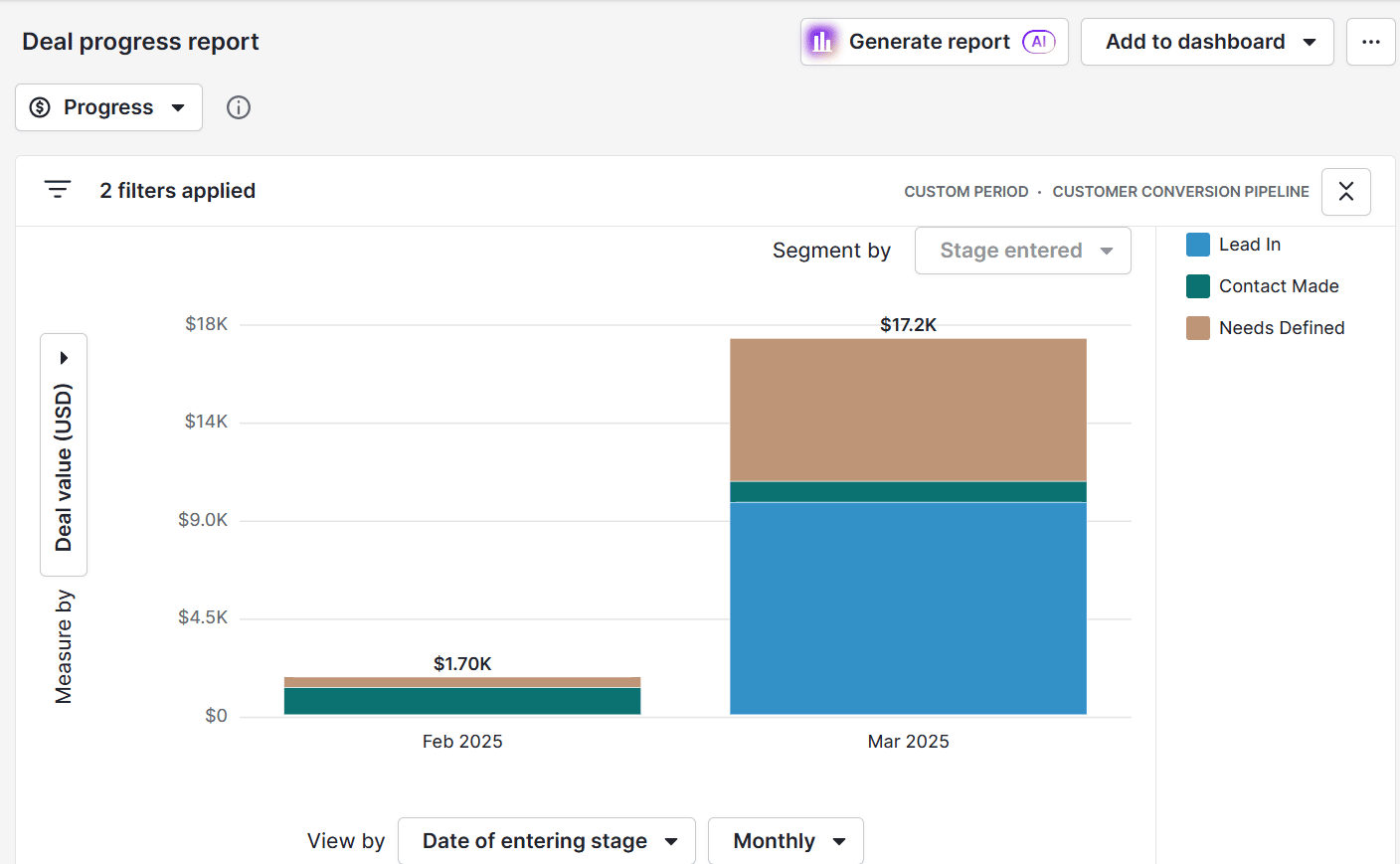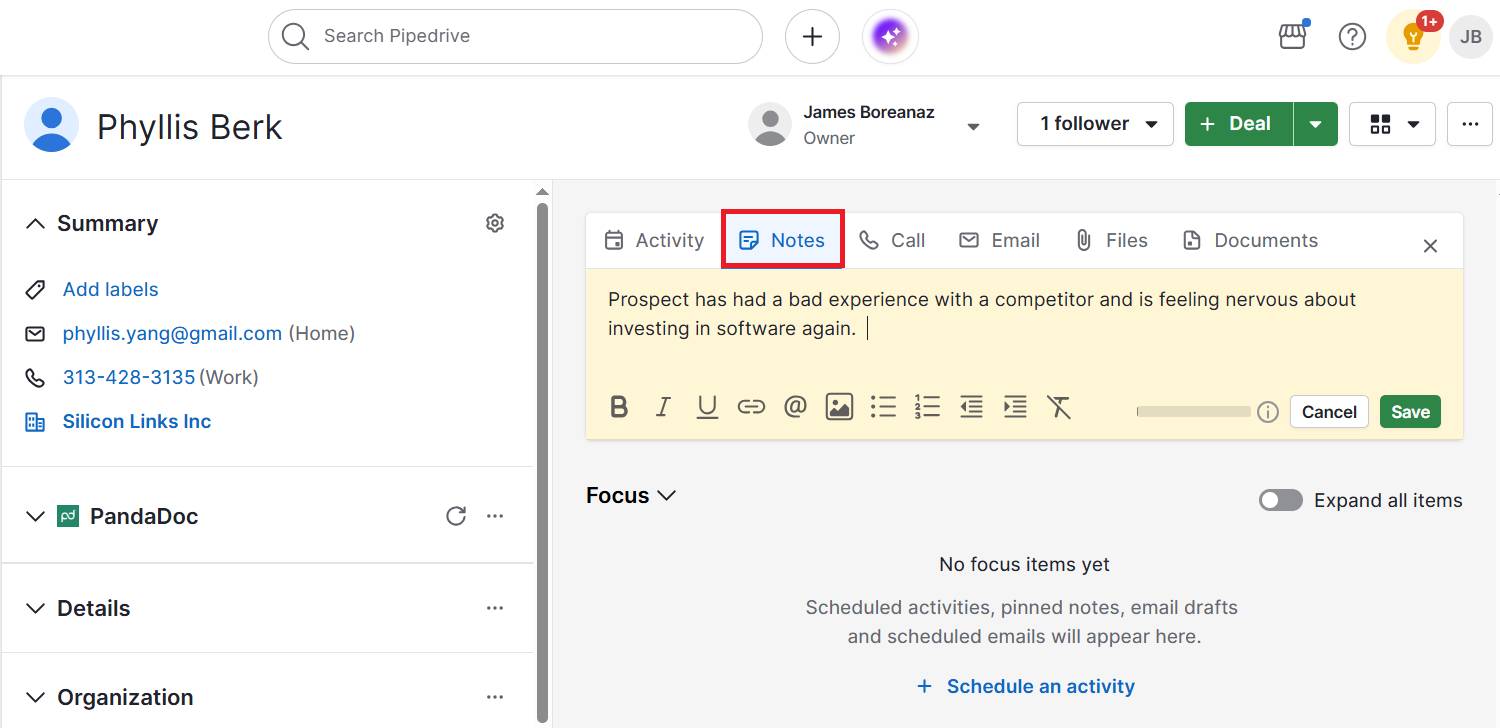Rich, data-driven customer profiling shows you precisely what drives your best buyers’ decisions and how to reach them with more precision. If your current profiles are too vague or based on guesswork, updating them is an easier fix than you’d think.
In this article, you’ll learn the psychology behind customer profiles and how to use them to refine your message, connect more deeply with your audience and close sales faster.
Key takeaways from customer profiling
Customer profiling means organizing buyer data into clear profiles that show who they are and what drives their decisions.
Successful customer profiles sharpen your marketing and sales efforts, while vague templates risk stereotypes or wasted effort.
Profiles are most effective when you base them on real customer data and refresh them regularly.
Pipedrive captures, segments and visualizes customer information so you can build stronger profiles and sell more effortlessly – try it free for 14 days.
What is customer profiling?
Customer profiling builds a clear picture of your ideal buyer by grouping shared traits like demographics, behavior, motivations and needs.
Different types of profiles help you understand specific elements, like who you’re selling to and why those people buy.
Small and medium-sized businesses (SMBs) use profiles to make data-driven decisions about marketing, sales and product development without wasting limited resources.
Customer profiling’s meaning is the same for business-to-business (B2B) and business-to-consumer (B2C) companies.
However, the information within them often differs:
B2B sales profiles focus on company-level traits (firmographics, budgets or buying committees)
B2C profiles focus on individual consumers (lifestyle, demographics, education level and personal buying patterns)
For example, here’s an ideal customer profile (ICP) template for a fictional B2B cybersecurity company:

This ICP shows who the best-fit customer is, what challenges drive urgency and who makes buying decisions at a glance.
With that information, the cybersecurity firm can focus sales and marketing on customers most likely to convert, rather than spreading time and budget across everyone.
Profiling helps SMBs:
Save money by targeting best-fit potential customers instead of people who will never buy
Improve ad relevance and conversion rates by tailoring messaging to specific pain points
Design better products or services by building features or offers around real customer needs you uncover
Increase customer loyalty and lifetime value (CLV) by creating personalized experiences and communication
Shorten the sales cycle by reaching decision-makers with relevant messages when they’re ready for them
Spot upsell and cross-sell opportunities by understanding customer behavior more deeply
Customer profiles give business owners clarity. Instead of casting a wide net and hoping, you can focus on the right people, solve their real problems and grow faster.
In fact, McKinsey research suggests that targeted offers – based on rich profiles in the background – convince 65% of customers to buy.
Next, you’ll explore the different types of profiles you’ll need to consider.
6 crucial types of customer profiles and what they teach you
Each type of customer profile looks at buyers from a different angle, including behavior, motivations or business context. By layering these insights, you understand who to target and why they’ll care.
Here are six of the most typical customer profiles and what you learn from them:
Type of customer profile | What it teaches you |
Demographic profile | Helps you understand who your buyers are at a basic level. Examples: Age, gender, income and education. |
Geographic profile | Shows where your customers live or operate and how these factors influence demand. Examples: Location, climate and urban vs. rural settings. |
Behavioral profile | Reveals how buyers interact with your product and what drives repeat purchases. Examples: Buying habits, product usage and brand loyalty. |
Psychographic profile | Tells you what customers care about and why they choose you over competitors. Examples: Values, lifestyle, interests and motivations. |
Firmographic profile | Identifies which types of businesses are the best fit for your solution. Examples: Company size, industry and revenue. |
Needs-based profile | Shows the pain points that spark urgency and purchase decisions. Examples: Specific problems or needs customers want you to solve. |
Think of these six profiles as ingredients. You can use them individually to learn about customers, but combining them gives you more powerful tools.
Imagine you run a small software company that sells workflow automation tools:
A firmographic profile shows your best customers are mid-sized agencies with 50–200 employees
A behavioral profile suggests these customers adopt new tools quickly if there’s a clear return on investment (ROI)
A needs-based profile indicates their biggest frustration is wasting time on manual sales reporting
These combined insights allow you to create specific, relevant resources to connect deeply with buyer segments and drive purchases.
Beyond merging profiles, you can transform raw profiles into two powerful formats that SMBs use every day:
ICPs. A description of the perfect-fit company (in B2B) that’s most likely to buy and get value from your product. More factual and criteria-based.
Buyer personas. Semi-fictional characters representing your ideal customer, complete with goals, challenges and behaviors. More human and story-driven.
Buyer personas and ICPs take the raw customer data from the six profile types and turn it into useful information for marketing, sales and product design.
Here’s why customer profiling resonates with buyers.
The psychological principles behind creating customer profiles
Customer profiling works because it taps into core human psychology. By aligning with how people pay attention, build trust and make decisions, you’ll connect with them far more effortlessly and improve the customer experience (CX).
Here are some of the most typical psychological principles behind customer profiles.
Selective attention theory: relevance and personalization
Selective attention theory: Our brains filter out most information and only process what feels relevant in the moment.
We’re bombarded with marketing every day, so only the messages that feel designed for us manage to cut through.
Profiles help you craft messages that mirror a customer’s real situation, so they notice you instead of tuning out.
Example: A small HR software company uses behavioral and firmographic profiles to send an email about automating onboarding to “fast-growing startups with under 200 employees”.
The message speaks directly to their size and pain point, so a startup founder notices it in her busy inbox. Instead of dismissing the offering as generic software, she sees a solution built for her team’s exact challenges.
That positioning increases response rates, shortens the sales cycle and makes startups far more likely to choose the consultancy over competitors.
Similar-to-me effect: trust-building
Similar-to-me effect: People naturally gravitate toward others they perceive as sharing their experiences, values or struggles
We’re more likely to trust (and buy from) people and brands who seem like us or show they understand our needs and challenges.
Understanding customer pain points shows empathy, which builds credibility. When your profile-based messaging mirrors people’s struggles, it creates a sense of shared experience.
Example: A consultancy uses needs-based and psychographic profiles to frame a new automated marketing campaign around “protecting small healthcare clinics from compliance headaches”.
A risk-averse clinic director immediately relates because it feels like the agency has worked with people like him.
Instead of another non-specific pitch, he sees a trusted partner who understands his need for compliance management and is far more likely to engage in a sales conversation.
Paradox of choice: decision simplification
Paradox of choice: More options increase anxiety, delay decisions and reduce satisfaction with the final selection.
The paradox of choice suggests that many options or vague information makes decision-making harder, to the point where we may not choose anything.
Our brains are wired to avoid overload. Customer profiles narrow your focus, letting you speak clearly to a defined group and reduce overwhelm for you and your target audience.
Example: A marketing firm uses firmographic and needs-based profiles to target “local restaurants needing online ordering systems”. A restaurant owner instantly knows the service is meant for them, making the decision far easier.
That clarity speeds up adoption, reduces price resistance and makes the firm the obvious choice over less tailored competitors.
5 steps to build effective customer profiles that drive sales
Customer profiles are most useful when you base them on real data. When you zero in on the right target customers and speak to their actual needs, you encourage more purchases.
For example, if you pinpoint that your fastest-closing deals come from 10–50-employee financial institutions with compliance challenges, you can focus your outreach on that exact segment.
This specificity results in shorter sales cycles, higher conversion rates and less money burned on broad, unfocused marketing.
Here’s a step-by-step process SMBs can follow to build profiles that move the needle.
1. Gather customer profile data using the right tools
Pull together insights from buyer surveys, sales history, web analytics and social media to spot patterns in your customers’ journey. This process gives you the “raw ingredients” to build accurate, actionable profiles.
Instead of assuming who your best customers are, you’ll know based on their actual behavior and traits.
Typical customer profiling methods include tools like:
Customer relationship management (CRM) data. Use systems like Pipedrive to track firmographics, deal stages and purchase history.
Web analytics. Use tools like Google Analytics to understand traffic sources, visitor tracking by page and conversion patterns.
Social media insights. Platforms like LinkedIn, Instagram or Facebook reveal audience demographic information, interests and engagement.
Support tickets and reviews. Look at what customers complain about, request or praise to identify recurring themes.
Customer profiling software like Pipedrive helps you automatically capture data from leads, deals and interactions to build a clear picture of your best buyers.
Real-time activity tracking lets you create reports to see how contact groups move through deal stages:

If specific segments often stall, you know you need to improve touchpoints somewhere along their buying journey.
Adding custom fields that you fill in after sales calls or meetings (e.g., “Pain points mentioned”, “Decision-makers involved” or “Budget considerations”) stores crucial details on contact records.
Here’s where you add custom fields in Pipedrive:
These details help you remember context and spot patterns by tracking which types of customers move fastest through the stages of your sales pipeline.
Data grounds your depictions in reality. By managing customer profiling in CRM tools like Pipedrive, you base templates on real behaviors, conversations and results.
2. Segment your audience
Customer segmentation divides your audience into smaller groups based on shared traits like roles, needs or behaviors. Instead of treating all customers the same, you create meaningful clusters that reflect how they actually buy.
By tailoring your sales and marketing efforts to each group, you increase relevance, personalize outreach and improve conversion rates. Without it, your messaging risks being too generic to resonate.
Imagine a translation platform that segments its customers into life sciences clinics and manufacturers. The clinics care most about compliance and data security, while the manufacturing companies want to save time.
By sending each group different messaging, the company doubles response and open rates compared to its old, one-size-fits-all approach.
You can segment customers for customer profiling by:
Demographics (e.g., age, income, role)
Firmographics (e.g., industry, company size, revenue)
Behavior (e.g., purchase frequency, deal velocity, product usage)
Needs (e.g., compliance-driven buyers vs. growth-driven buyers)
Buying stage (e.g., new lead, engaged sales prospect, repeat customer)
For example, you can segment easily within Pipdrive by applying tags and filters like industry, company size or buying stage:
Use these features to quickly pull up all leads that fit a particular profile and customize your approach.
Turning raw data into actionable groups sends the right message to prospects most likely to buy your product.
Pipedrive in action: Travel booking software provider TrekkSoft used Pipedrive to create targeted segments and personalize outreach. By understanding its audience and sending them tailored messages, TrekkSoft doubled sign-ups and quadrupled productivity.
3. Interview past and current customers
Customer interviews enrich your profiles by helping you understand the “why” behind data collection (i.e., motivations, frustrations and challenges that don’t appear in analytics).
Speaking to existing customers and past buyers uncovers emotional drivers and context behind buying decisions.
Using the language from interviews in your sales and marketing makes your messaging and offers far more persuasive.
For example, an employee management platform learns through Zoom calls that startups aren’t just buying tools to speed up processes. They’re stressed about losing new hires due to “clunky onboarding”.
That insight shapes future sales pitches from “automate HR tasks” to “avoid clunky onboarding and keep new hires engaged from day one”, which resonates much more strongly.
Here are some examples of interview questions that help you develop your profiles:

If you’re interviewing for the first or the hundredth time, here’s how to get the most insightful customer feedback:
Pinpoint a mix of loyal customers and churned ones to interview for a range of opinions
Reach out to offer interviews in person, virtually and in group settings so people feel comfortable enough to share experiences
Ask open-ended questions about goals, pain points and what drove their decision to buy or unsubscribe
Listen for repeated themes like “too expensive”, “too complex” or “easy to use”
Note exact words and phrases customers use, as these can be gold for your marketing copy
After each interview, add notes directly to the customer’s contact record in Pipedrive:

Over time, you’ll create a searchable library of real-world motivations to refine your ICPs or buyer personas.
4. Identify key pain points and goals
Map out the specific problems your segments face and the outcomes they’re chasing. Pain points show what’s frustrating buyers right now. Goals reveal what success looks like in their eyes.
When you understand and include both in your profiles, you can position your product as the bridge between the two. Instead of selling features, you promise far more compelling outcomes.
Imagine an IT services firm that learns small law offices are frustrated by frequent downtime (pain) and want smoother client communication (goal).
They decide to create new targeted marketing strategies around the message:
“Keeping your systems reliable 24/7 so you never miss a client call”
By speaking directly to what matters most, the firm wins attention and aligns its internal processes around reliability. This focus improves both marketing impact and customer satisfaction.
Here’s how to collect and act on these valuable insights:
Review interview notes for recurring complaints and frustrations
Look at churn surveys or support tickets to spot what drives dissatisfaction
Ask customers directly, “What does success look like for you six months from now?”
Create a simple table for each segment that outlines the pain point, goal and how you’ll fit it
Knowing your customers’ struggles and ambitions makes your sales team’s approach feel more like selling a solution than a pitch.
By clearly identifying which pains are most urgent across your sales pipeline, you can adjust messaging accurately, prioritize features and refine your ICP.
5. Create accurate customer profiles
Bring your insights from data and interviews into a clear profile that your team can refer to. Each one should read like a snapshot of a real customer segment.
A well-crafted profile keeps sales, marketing and product aligned on who you’re serving, what they need and how to reach them. Without it, small teams risk making decisions based on assumptions or scattered anecdotes.
Profiles can be as in-depth or as brief as you like. However, the insights must be specific to be useful.
Note: While limited profiles (e.g., geographic or firmographic) are crucial for gathering specific insights, combining them into ICPs or buyer personas gives you a well-rounded picture of each customer group.
For instance, a software-as-a-service (SaaS) startup may create a profile called “Growth-Minded Operations Manager” that includes:
Background – works at a mid-size logistics company and manages a team of 10
Needs – wants to automate manual reporting to save time
Objections – worries about high implementation costs
Preferred communication channels – responds best to LinkedIn content and webinars
With this customer information, the startup’s sales reps have a clear playbook for outreach and tailoring conversations, while the marketing team knows which channels to double down on.
Here’s how to create and use customer profiles effectively:
Give each profile a memorable name for seamless searching (e.g., “Budget-Focused Owner” or “Scaling Startup CTO”)
Add background details (e.g., job title, company size, demographics or firmographics)
List the top challenges, goals and likely objections to buying
Include preferred communication channels to make customer outreach easier
Keep it concise to understand notes at a glance (one page per profile is usually enough)
Review and update quarterly as you gather new data points
To make things even simpler, download Pipedrive’s customer profile template to structure your profiles.
Fill in each ICP using data from your CRM, interviews and notes.
Download your ideal customer profile template
As you refine your profiles over time, update the documents and share them across teams to keep everyone aligned.
Test your assumptions, refresh them with new insights and let them evolve with your customer base.
Fictional B2B customer profile examples to inspire your own
If you haven’t created a customer profile before, fictional examples can help to inspire the phrasing and level of detail to include.
The information will differ depending on the type and relevant factors. For instance, demographic profiles tell you buyer basics like age or income, while psychographic versions reveal attitudes and values.
Here are four examples to help visualize what yours could look like.
Ideal customer profile (ICP) example
An ICP zooms out to the company level, showing which organizations are the best overall fit for your product.
It captures traits like size, industry and business growth stage so you can determine where to focus sales and marketing energy.
For instance, a scaling B2B SaaS company that just raised funding has very different needs than a mature enterprise. An ICP helps you identify which of those contexts is the “sweet spot” for your solution.
Here are the details you could include in yours:
Profile name | Scaling SaaS Startup CTO |
Industry | Human resources |
Company size | Approximately 50–200 employees |
Key needs | Automating employee onboarding and reducing churn |
Buying triggers | The company has just raised Series A and is hiring rapidly |
Preferred channels | LinkedIn, SaaS founder Slack groups and B2B podcasts |
Buyer persona profile example
A buyer persona drills down to the human level (i.e., the individual decision-maker or user inside the company).
While the ICP tells you which business, the fictional persona explains who exactly you need to persuade and how.
For example, the needs and objections of a budget-conscious clinic director will look very different from those of a tech-savvy operations manager.
Use this persona example to tailor messaging to motivations, fears and daily challenges:
Profile name | The Cost-Conscious Clinic Director |
Background | Runs a small women’s health clinic |
Goals | Keep operations compliant and manage budget tightly |
Challenges | Limited staff with a high admin burden |
Objections | Concerned about software costs and staff adoption |
Preferred channels | Vendor email newsletters and compliance webinars |
Download this buyer persona template from Pipedrive to get started creating your own:
Better understand your customers with our Buyer Persona Templates
Geographic profile example
A geographic profile isn’t just about the pin on the map. It’s about the context of location and how that shapes customer needs.
For example, a rural manufacturer in the Midwest may need reliable logistics and equipment servicing because suppliers are hours away. On the other hand, an urban startup in NYC cares more about office space cost and tech talent competition.
Here are some of the factors to consider:
Region | Pacific Northwest (US) |
Urban vs. rural | Rural – towns under 10,000 people |
Climate | Rain-heavy, mild winters |
Local economy | Agriculture and light manufacturing |
Infrastructure | Limited broadband and high shipping costs |
Implication | Marketing needs to stress reliable offline support and affordable logistics solutions |
Behavioral profile example
A behavioral profile looks past who the customer is and focuses on what they do. It highlights buying habits, product usage and loyalty patterns that reveal how people interact with your business over time.
For SMBs, this often means studying the end user’s behaviors (like repeat purchases, trial-to-paid conversion or churn triggers) rather than just the organization’s processes.
These insights help you predict future actions and design interventions that keep customers engaged:
Purchase frequency | Buys marketing software once every 2 years |
Usage patterns | Logs into the platform daily, but only uses reporting dashboards weekly |
Decision triggers | Upgrades when the current software limits team productivity |
Buying journey | Always researches reviews on G2 and watches YouTube demos before contacting sales |
Brand loyalty | Tends to stick with vendors if customer service is responsive |
Purchase drivers | Discounts, referrals from peers and strong customer support |
Each type of profile captures different dimensions of your audience, from where they’re based and how they behave to what they value most.
Choose a mix that gives you the clearest picture of who buys from you and why. Start simple, then refine over time as you gather more data and insights.
Final thoughts
Customer profiling gives SMBs the clarity to focus on people most likely to buy, cut wasted spend and design offers that actually resonate.
The key to a successful strategy is having the right technology to automatically collect data and keep it accurate and actionable.
Try Pipedrive free for 14 days to build richer customer profiles, shorten sales cycles and drive retention and loyalty.







